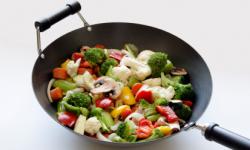How To Clean A Wok After Cooking
Although the regional cuisines of China and other Asian countries vary in flavors and ingredients, the unifying link between them is the wok as the primary cooking vessel. The wok evolved centuries ago as a result of fuel shortages. Its rounded shape and long sloping sides provide an extended cooking surface, which may be heated to very high temperatures with little fuel. The wok is most commonly associated with the technique of stir-frying, but can be used to deep-fry, braise, roast, steam, and simmer. 
©iStockphoto.com/Joshua Holder
Woks are great tools for Asian cuisine.
Cooking with a Wok
There are a few common guidelines for all types of wok cooking that should be kept in mind.
- Preparation and cooking are two separate procedures. Carefully read the entire recipe before beginning. All ingredients should be prepared before cooking.

Prepare all ingredients before cooking. - Attention to the cooking process is crucial because most foods are cooked over intense heat in a matter of minutes. The intensity of the heat used for wok cooking is important. In most cases, easily controlled high heat is needed. For this reason, a gas range with its instant heat control is generally more efficient than an electric range or electric wok.
- The kind of oil used is also crucial. A vegetable oil that may be heated to a high temperature without smoking is essential. Peanut oil, corn oil, and soybean oil all work well. Other kinds of fats, such as olive oil, sesame oil, or butter should not be used because they burn easily.
- Due to the variables, such as kinds of foods, type of heat, and the kind of cooking equipment used, cooking times given in recipes should be used as guidelines -- not as absolutes.
- Special wok accessories aren't necessary for success, but they can make wok cooking easier. If you will be doing a great deal of wok cooking, you might want to stock your kitchen with some custom utensils.

Clockwise from top left: bamboo steamer,
wok, deep-fry thermometer, wire steamer
rack, chopsticks, bamboo brush,
and Chinese spatula.
Stir-Frying
This is a rapid-cooking method invented by the Chinese. It is the brisk cooking of small pieces of ingredients in hot oil over intense heat for a short time.
- Organize and prepare all ingredients before beginning to cook. Clean and chop garlic, ginger, and herbs. Measure and mix ingredients for sauces or thickeners. Cut meat, poultry, fish, and vegetables into pieces of about the same size to ensure even cooking.

Cut ingredients into even-sized pieces. - Heat wok over medium-high heat 1 minute or until hot. Drizzle oil into wok and heat 30 seconds.
A Chinese spatula is a handy tool for stir-frying. This long-handled utensil has a wide, flared, rounded metal edge that conforms to the shape of the wok. It is used for stirring and tossing the food. A wooden spoon also may be used and will not harm nonstick surfaces.
- Add food pieces in small batches. Most recipes call for stir-frying meat or poultry first, followed by faster cooking vegetables. Cook ingredients until done, keeping them in constant motion by stirring or tossing vigorously. Remove from wok and keep warm. Repeat with remaining ingredients.

Stir vigorously.
- Once cooking is completed, remove wok from heat and serve food immediately.
Bamboo Steaming
Steaming in a wok usually involves a Bamboo Steamer -- a round basket that holds food over steaming water, allowing the steam to cook the food. The basket is about 31/2 inches deep with a base of loosely woven bamboo strips that allows steam in for cooking. The lid is more tightly woven, with no spaces for the steam to escape. Since bamboo steamers come in a wide range of diameters, find one that will fit snugly inside your wok, resting about 1 inch below the edge. A 12-inch basket fits nicely in a 14-inch wok.

Place steamer in wok.
Wire Steamer Rack
Wire steamer racks that fit in the wok may also be used for steaming and are especially good for braising and smoking. A round wire cooling rack may be used.

Place plate in wok.
Deep-Frying
Using a deep-frying thermometer is always recommended for best results. This kitchen thermometer registers heat from 100 degrees Fahrenheit to 400 degrees Fahrenheit and should be long enough to clip onto the side of the wok so both hands may remain free during cooking. The thermometer's bulb should not touch the bottom or edge of the wok in order to obtain the most accurate reading. Deep-frying in a wok is exactly like deep-frying in any stovetop pot. The most important things to remember are using extreme caution and making sure that the oil in the wok reaches and maintains the proper frying temperature. Not what you're looking for? Try these:

Remove fried food with slotted spoon.
How To Clean A Wok After Cooking
Source: https://recipes.howstuffworks.com/tools-and-techniques/wok-cooking.htm#pt3
Posted by: rodriguezaguied.blogspot.com

0 Response to "How To Clean A Wok After Cooking"
Post a Comment